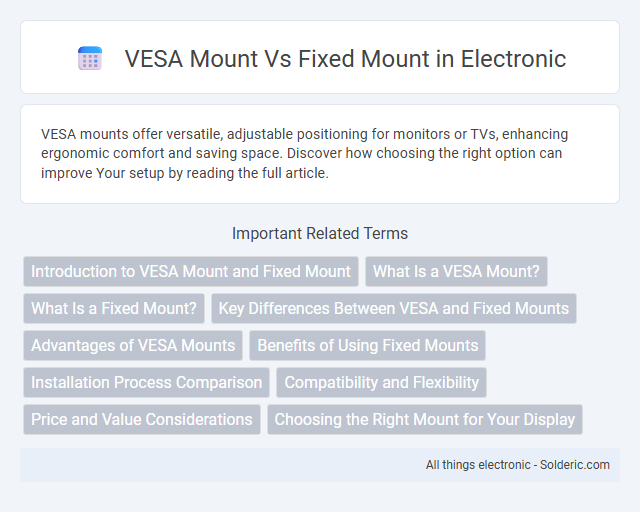VESA mounts offer versatile, adjustable positioning for monitors or TVs, enhancing ergonomic comfort and saving space. Discover how choosing the right option can improve Your setup by reading the full article.
Comparison Table
| Feature | VESA Mount | Fixed Mount |
|---|---|---|
| Compatibility | Standardized mounting holes (e.g., 75x75mm, 100x100mm) | Designed for specific devices or models |
| Adjustability | Allows swiveling, tilting, and height adjustment | No movement; screen remains in a fixed position |
| Installation | Requires alignment with VESA patterns on device | Simple, direct attachment to wall or surface |
| Use Cases | Ideal for flexible viewing angles and ergonomic setups | Best for stable, permanent installations |
| Cost | Generally more expensive due to complexity | Usually lower cost, simpler design |
| Weight Support | Supports a wide range of weights based on model | Weight support depends on mount and fixings |
Introduction to VESA Mount and Fixed Mount
VESA mounts adhere to standards set by the Video Electronics Standards Association, allowing compatibility between various monitors and mounting arms with precise hole patterns such as 75x75mm or 100x100mm. Fixed mounts provide a secure, stationary solution designed to hold displays firmly against walls without allowing tilt or swivel adjustments. Choosing between VESA and fixed mounts depends on the need for flexibility in screen positioning versus a stable, flush setup.
What Is a VESA Mount?
A VESA mount is a standardized mounting interface defined by the Video Electronics Standards Association, designed to securely attach monitors, TVs, and displays to mounting brackets or arms. It features specific hole patterns on the back of screens, such as 75x75 mm or 100x100 mm, allowing compatibility with various stands and wall mounts. Your choice of a VESA mount ensures flexibility and ease when positioning or upgrading your display setup.
What Is a Fixed Mount?
A fixed mount is a type of VESA mount designed to hold a display screen securely in a stationary position without any tilting, swiveling, or extending capabilities. It is ideal for creating a clean, space-saving setup with screens positioned flat against the wall or mounting surface. Fixed mounts support various screen sizes and weights while providing robust stability and a sleek, low-profile appearance.
Key Differences Between VESA and Fixed Mounts
VESA mounts feature standardized hole patterns (e.g., 75x75mm, 100x100mm) that enable compatibility with various monitors and allow adjustable positioning, including tilt, swivel, and rotation. Fixed mounts, in contrast, provide a stationary solution with no movement options, offering simplicity and stability for displays in a permanent position. Your choice depends on whether flexibility with screen orientation or a secure, immovable setup is the priority.
Advantages of VESA Mounts
VESA mounts provide exceptional flexibility by allowing easy adjustments in height, tilt, and rotation, making them ideal for ergonomic setups and multi-monitor configurations. Their standardized design ensures compatibility with a wide range of monitors and TVs, simplifying installation and upgrades. You benefit from cleaner cable management and maximized desk space, enhancing both functionality and aesthetics.
Benefits of Using Fixed Mounts
Fixed mounts provide a sturdy and secure solution for your TV or monitor installation, minimizing movement and ensuring a stable viewing experience. They are typically more cost-effective and easier to install compared to adjustable mounts, making them ideal for rooms where viewing angles are consistent. By using fixed mounts, you maximize space efficiency and maintain a sleek, low-profile appearance on your wall.
Installation Process Comparison
VESA mounts offer a standardized installation process compatible with most monitors and TVs, featuring pre-drilled holes and mounting brackets that simplify alignment and attachment. Fixed mounts require precise wall placement and secure anchoring, often involving more detailed measurements to ensure stability and correct screen positioning. Your choice impacts installation speed and flexibility, with VESA mounts generally providing quicker, more adaptable setups.
Compatibility and Flexibility
VESA mounts offer greater compatibility with a wide range of monitors and TVs due to standardized hole patterns, making it easier to switch or upgrade displays. Fixed mounts provide limited flexibility as they hold the screen in a stationary position, ideal for stability but restricting adjustment options. For users prioritizing adaptability and future-proof setups, VESA mounts deliver superior flexibility compared to fixed mounts.
Price and Value Considerations
VESA mounts typically offer flexible positioning options and easier installation, often available at a moderate price range that balances cost with versatility. Fixed mounts usually come at a lower price point, providing a stable and secure setup without the extra features of adjustability, making them a cost-effective choice for those prioritizing simplicity and durability. When evaluating price and value, your decision should align with whether you prefer the convenience of adjustability or the straightforward reliability of a fixed setup.
Choosing the Right Mount for Your Display
Choosing the right mount for your display depends on your space, viewing preferences, and compatibility needs. VESA mounts offer flexibility with adjustable angles and easy repositioning, making them ideal for dynamic workspaces or multi-monitor setups. Fixed mounts provide a sturdy, low-profile solution perfect for minimalistic setups where the display remains at a consistent height and angle.
VESA mount vs Fixed mount Infographic

 solderic.com
solderic.com